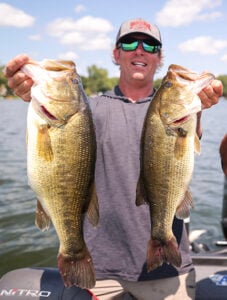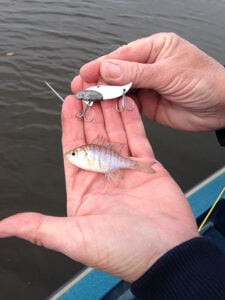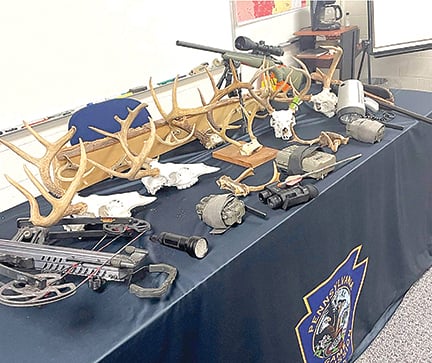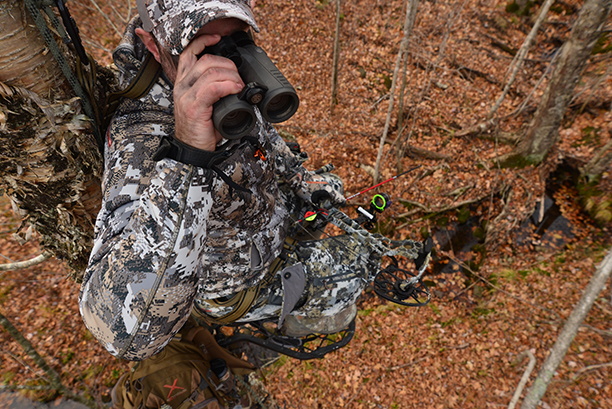Understand the forage to become a better bass angler – Outdoor News
Outdoor News may earn revenue from products shown on this page by participating in affiliate programs. Click here to learn more.
If you’re like most bass anglers, you go to the lake, tie on favorite baits and head to spots where you’ve caught them before. If that doesn’t get you many bites, you switch baits and try another spot.
And another spot.
That can work, but don’t overlook one of the biggest factors to dialing up more action; the bass dinner table. The food source is every fish’s key to survival and bass want to be nearby. Identify their primary target and you’re on the path to success.
However, lakes offer multiple forage options. A bass’s preferred dining can change day to day. It could be bluegills, emerald shiners, crayfish or perch on most lakes while some include alewives, smelt, or even gizzard shad.
Bass are opportunistic feeders. They target what’s most available and easiest to find.
No one knows that better than Kalamazoo, Mich., angler Neil Vande Biezen who has fished lakes throughout the Upper Midwest.
“Once you know the forage and areas that forage is using, you’ve narrowed the search for locating the bass,” he said.
MORE BASS COVERAGE FROM OUTDOOR NEWS:
Here’s how to work the remarkably weedless, deadly effective bladed jig
Here’s how Minnesota’s Easton Fothergill won on bass fishing’s biggest stage
Jigs and swimbaits are a simple but effective approach for spring bass
If you’re unfamiliar with a lake, local fish agencies’ biological surveys can offer clues. Once you know the primary forage, study that forage’s habits.
For example, crayfish, perch, and bluegills will lounge near the bottom or around vegetation where they feed on tiny insects. While crayfish prefer rock, gravel, and sand bottoms, they can be found in most depths and any place that provides cover.
Of course, bluegills also will suspend, especially during the summer. Given the bluegill’s popularity on largemouth lakes, locating where local bluegill anglers are grouped will provide another clue.

Vande Biezen relies on electronics. He idles around monitoring his down- and side-view electronics, watching closely for big balls of baitfish.
“When I see pods of baitfish suspended, I fish mid depths or near the surface with swimbaits, small jig/minnow combos, or A rigs,” he said. “If I see bait near the bottom, I use bottom bumping lures, like a jig or drop-shot, or slow-roll something like a Strike King Rage Swimmer or Homing Minnow.”
Shallow water can be difficult to read, but any fish you catch can provide clues.
“You may see a baitfish sticking out of the throat of a bass, or check the livewell periodically for any pieces that a bass may have regurgitated,” Vande Biezen said. “That can tell you a lot.”
And sometimes, it pays to give fish a sniff test.
“Bass that are eating crayfish will have an odor and downright stink,” he said. “When I smell that, I know to fish crayfish style baits.”
Match the hatch?
Lure size and color are important considerations after identifying the forage. Matching forage size, color, and movement is important.
But not always.

Smallmouth bass, for example, have an affinity for something chartreuse, which is far from natural. Generally though, natural or translucent colors tend to be more productive in clear water.
“I try to select colors that resemble the forage, but with a preference for lighter shades in clear water and darker versions when there is an algae bloom or stained water,” Vande Biezen said.
If you want the most bites, opt for smaller lure sizes.
“But I often go to a larger version to attract bigger bites,” he said. “I think it helps. You may not get as many bites, but I think the size of bass overall will be better.”
If using jigs with plastics for suspended fish, he opts for a lighter jig that allows him to mimic swimming baitfish more efficiently.
“But it’s always important to play with lure speed,” Vande Biezen said. “If bass are reacting to a slower pace, upsize your jighead and fish it faster over the top of the baitfish.”
When fishing on or near the bottom, jigs in the 3⁄8- or 1⁄2- ounce are popular. Vande Biezen prefers to go heavier, such as a 3⁄4- ounce skirted jig with a plastic trailer.
“I can maintain bottom contact better and keep it moving to trigger reaction strikes,” he said.
Finding the preferred forage is critical to unlocking the door to more bass action, but you still have to experiment with lures and presentations.
“And remember, bass preferences can change overnight and throughout the year,” Vande Biezen said. “Figuring that out is a big part of the bass fishing intrigue, and honestly, makes it more rewarding once you get dialed in.”
Source: https://www.outdoornews.com/2025/05/02/understand-the-forage-to-become-a-better-bass-angler/







